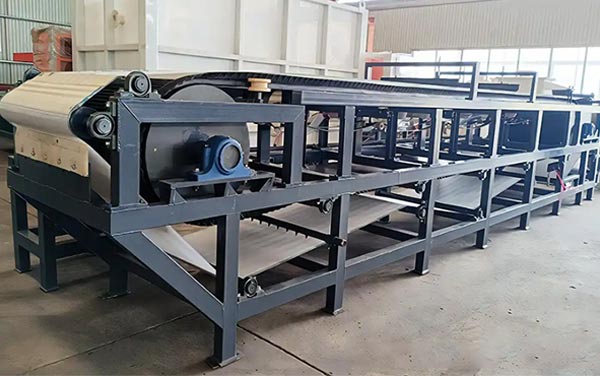Whether in mining, chemical processing, or environmental protection, belt vacuum filters have gradually become indispensable equipment across numerous industries due to their exceptional dewatering performance and highly efficient operational capabilities.

Working Principle of Belt Vacuum Filter
The working principle of a belt vacuum filter can be simply summarized as follows: it achieves separation of solids from liquids through a combination of negative pressure suction and belt conveyance. The specific structural process is as follows:
1. Material Infeed: The slurry first enters the filter screen through the feed inlet, typically consisting of a multi-layer filter mesh or a filter belt made of synthetic fabric.
2. Filter Belt Conveyance: Once the slurry is evenly distributed across the filter belt, the belt begins rotating. As it moves, solid particles are retained on the belt surface.
3. Vacuum Suction: A vacuum chamber beneath the filter belt applies suction to further separate liquid from solid particles. Vacuum intensity is adjustable to accommodate varying material requirements.
4. Washing and Drying: After solids are filtered out, the system can add clean water for washing to ensure particle purity. Simultaneously, vacuum suction further removes moisture, achieving a higher degree of dryness for the solids.
5. Discharge: The dewatered and washed solids are finally discharged through the outlet, completing the entire filtration process.
Structural Features of Belt Vacuum Filters
The precision-engineered design of belt vacuum filters ensures stable performance even under high-intensity operations.
1. Filter Belt Design: The filter belt utilizes high-strength polyester material or metal mesh, offering excellent filtration performance and wear resistance.
2. Vacuum System: A powerful vacuum system is a key feature. Through efficient vacuum pumps and optimized sealing design, it effectively enhances vacuum pressure, thereby improving dewatering efficiency.
3. Intelligent Control System: Modern belt vacuum filters are equipped with smart control systems that monitor operational parameters in real time, automatically adjusting vacuum levels and filter belt speeds to ensure efficient and stable operation.
4. Durability and Maintenance: All core components are constructed from corrosion-resistant materials, ensuring long-term durability while minimizing maintenance costs.
Advantages of Belt Vacuum Filters
1. High-efficiency dewatering: Belt vacuum filters achieve high dewatering rates, effectively reducing moisture content in materials and saving energy in subsequent drying processes.
2. Wide applicability: Suitable for mineral slurries, wastewater from chemical processes, and waste pulp generated in papermaking.
3. Robust Continuous Operation: With rational equipment design, it enables 24-hour continuous operation, significantly boosting production efficiency.
4. Superior Environmental Performance: Through efficient filtration and dewatering, it effectively reduces wastewater and solid waste discharge, contributing to environmental protection goals.
Summary
The intelligence and automation levels of belt vacuum filters will continue to advance. In the future, these devices will incorporate more sophisticated intelligent algorithms capable of adaptive adjustments based on actual production environments and material properties, thereby enhancing filtration efficiency and production output.
With its highly efficient operating principle and broad application scope, the belt vacuum filter is increasingly becoming a valuable piece of equipment in modern industry. Understanding the working principle and structural features of belt vacuum filters is crucial for professionals in related industries, helping enterprises gain a competitive edge in the fiercely competitive market.







